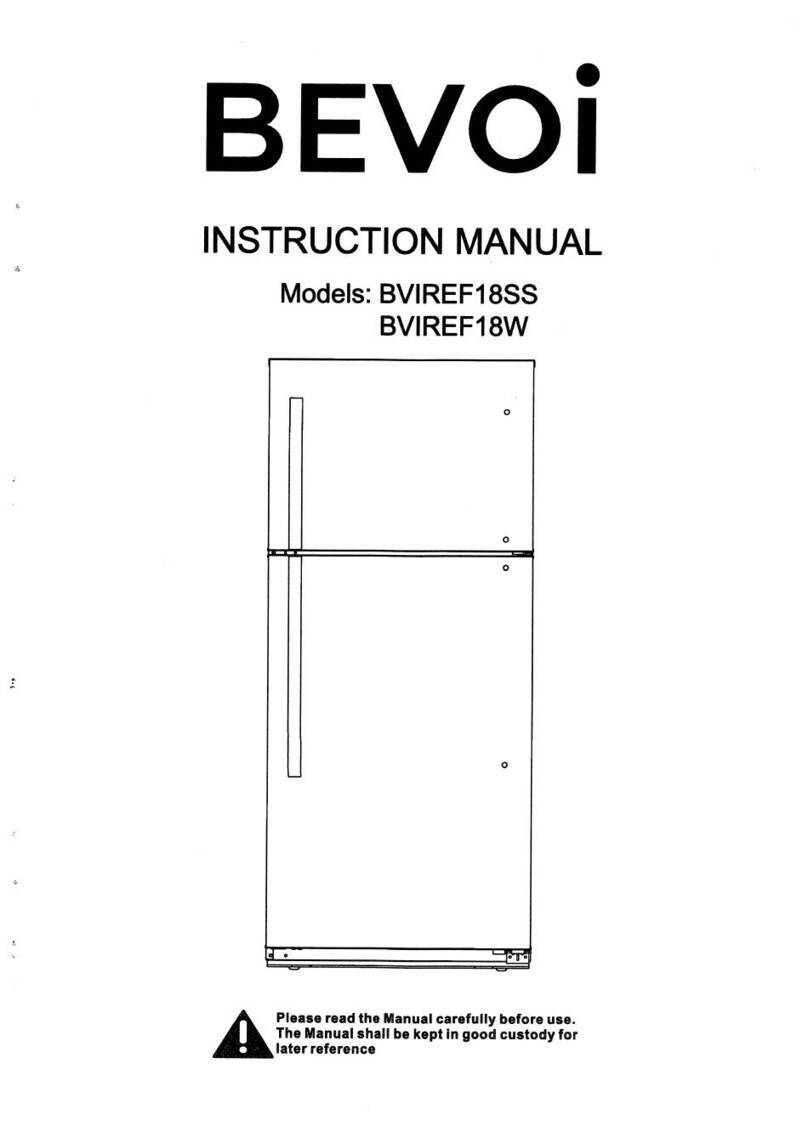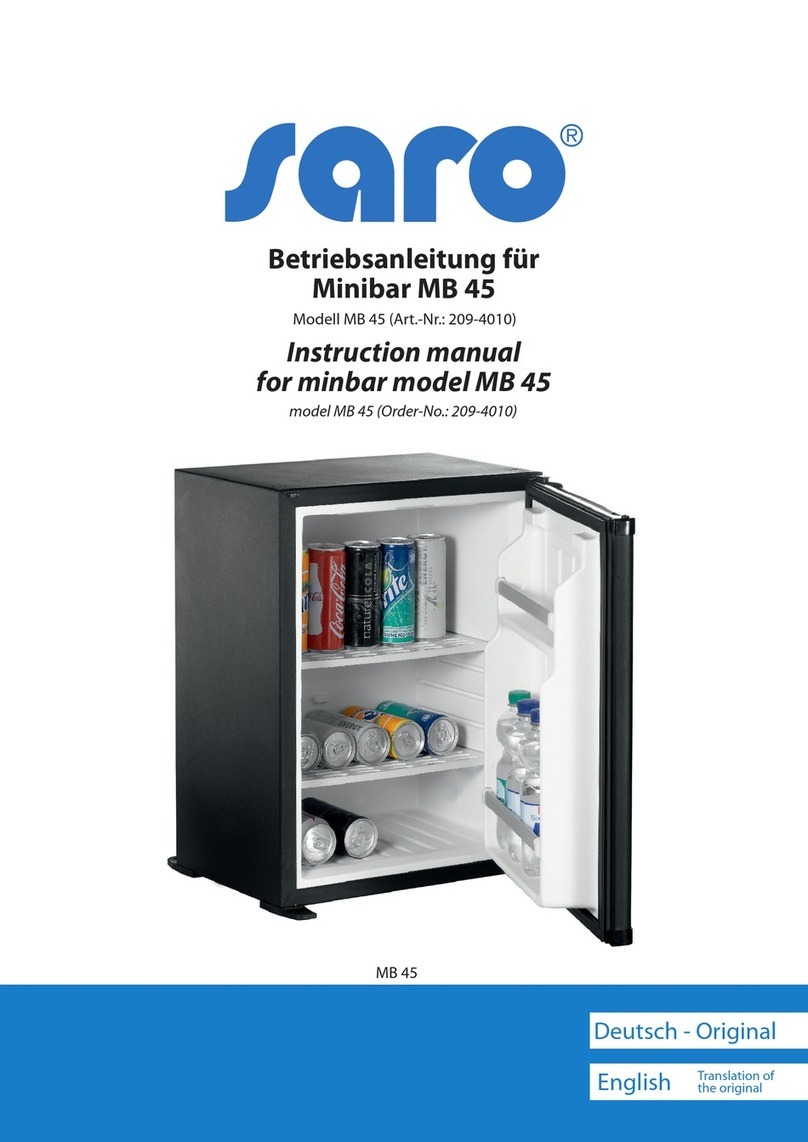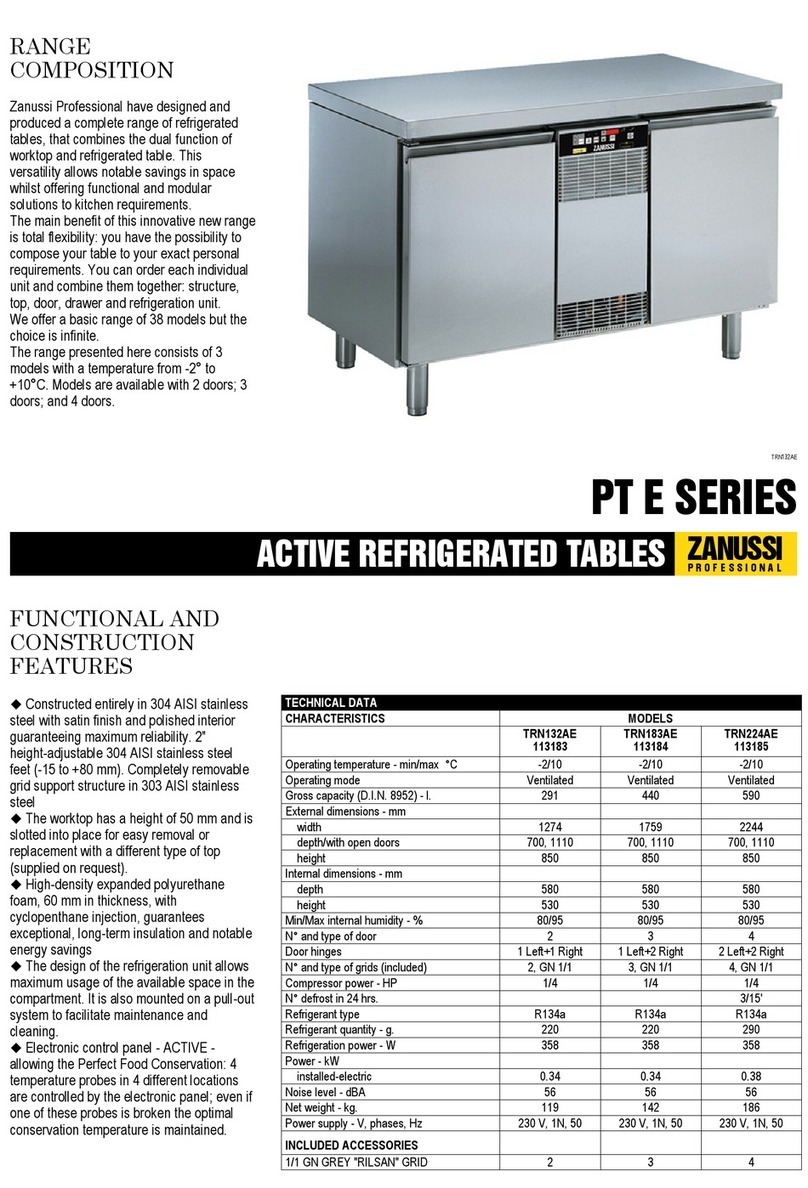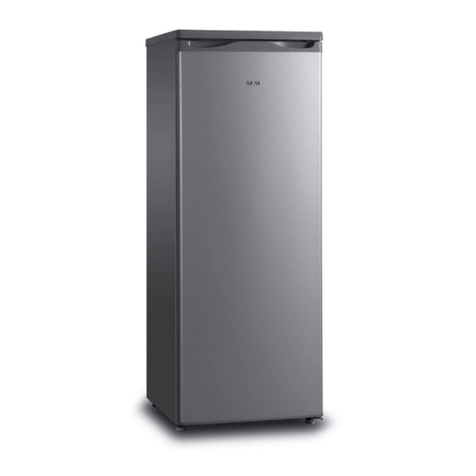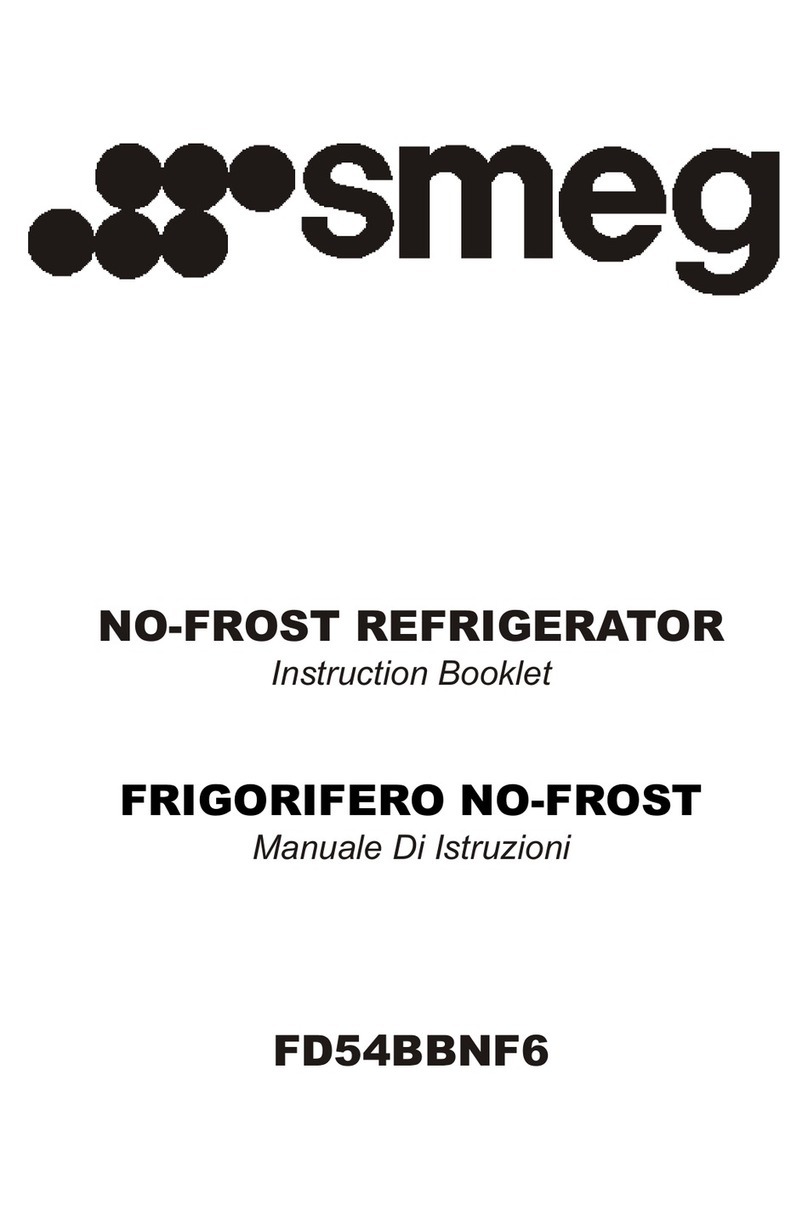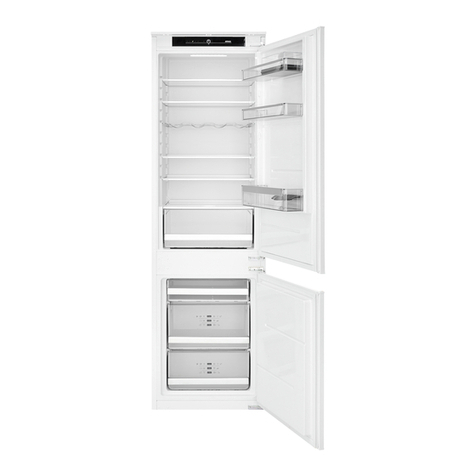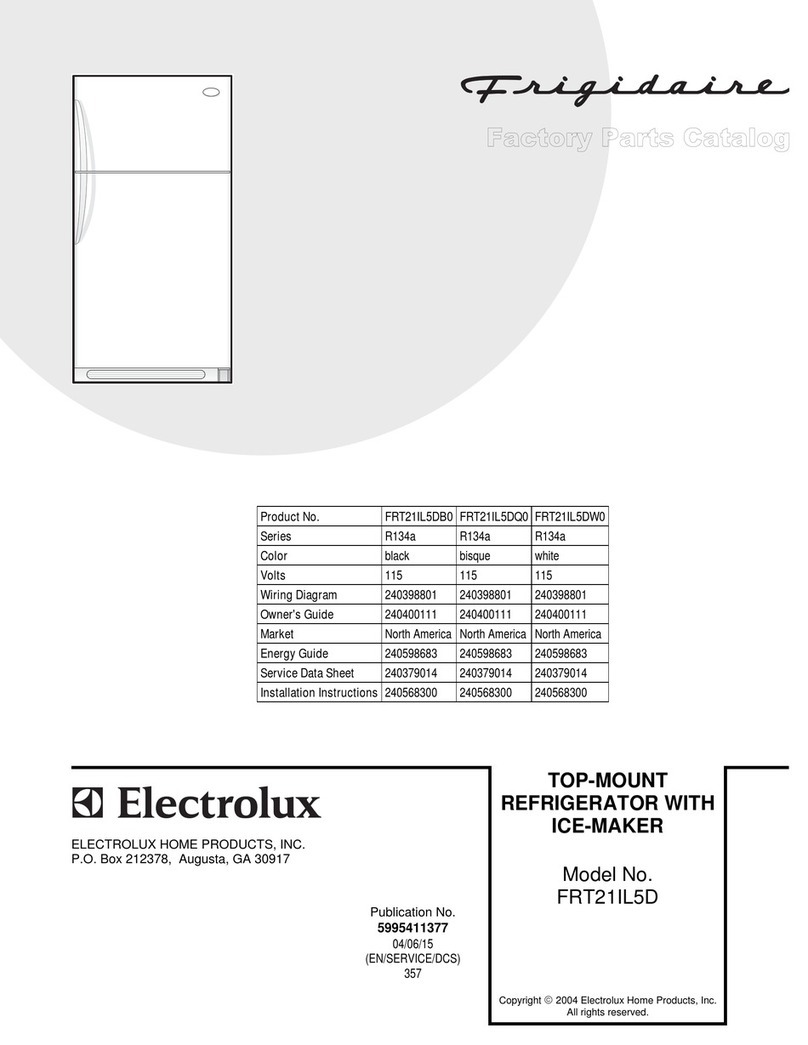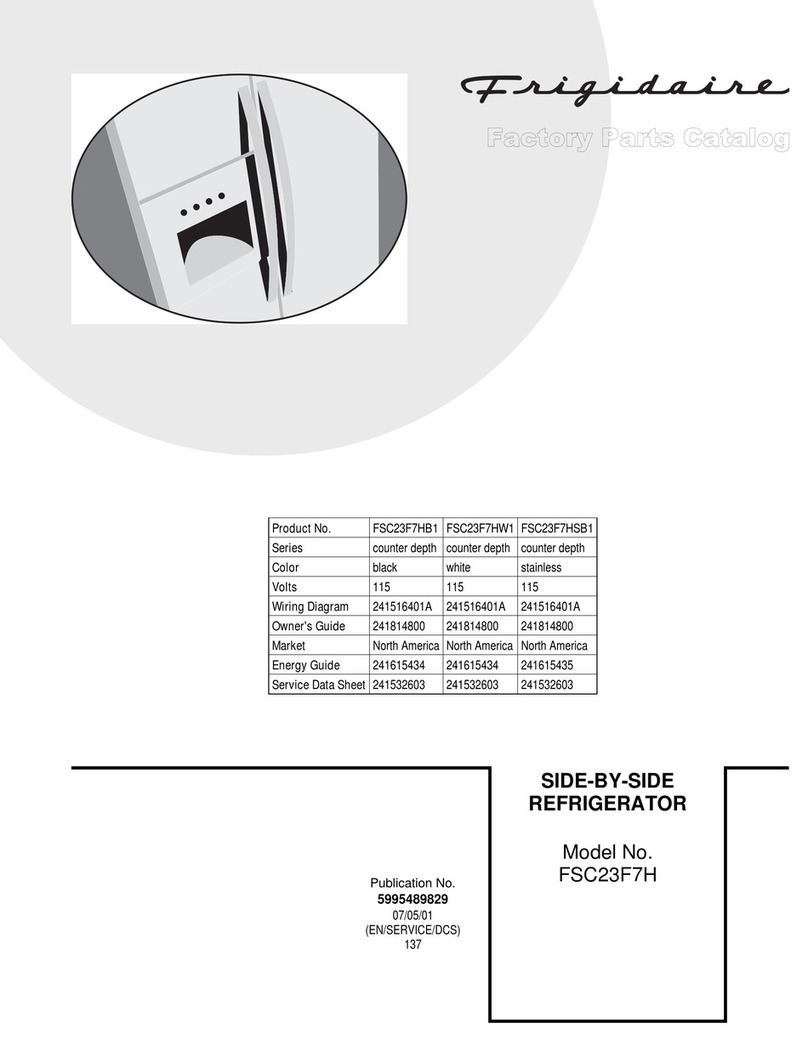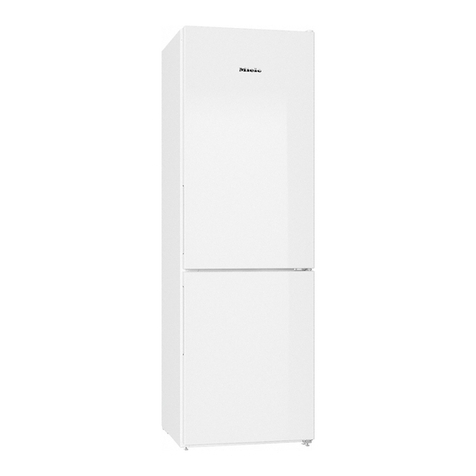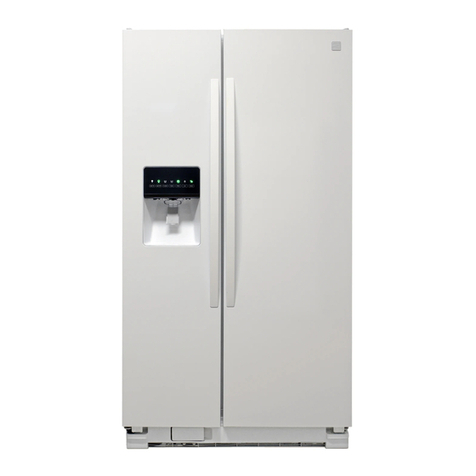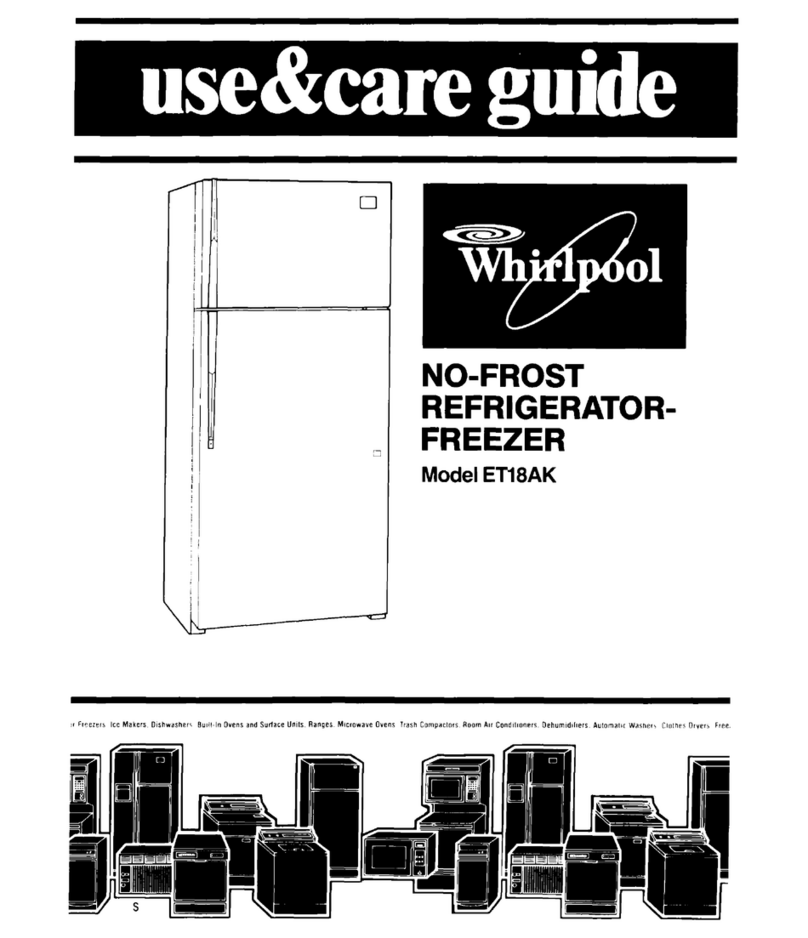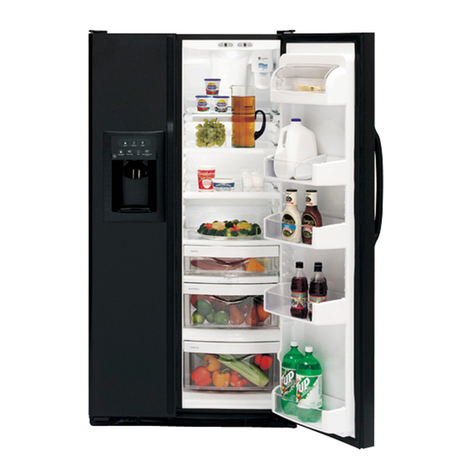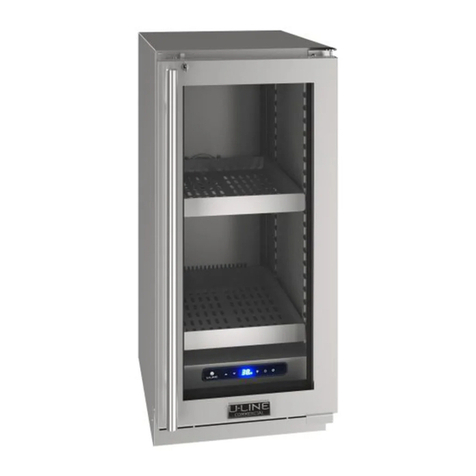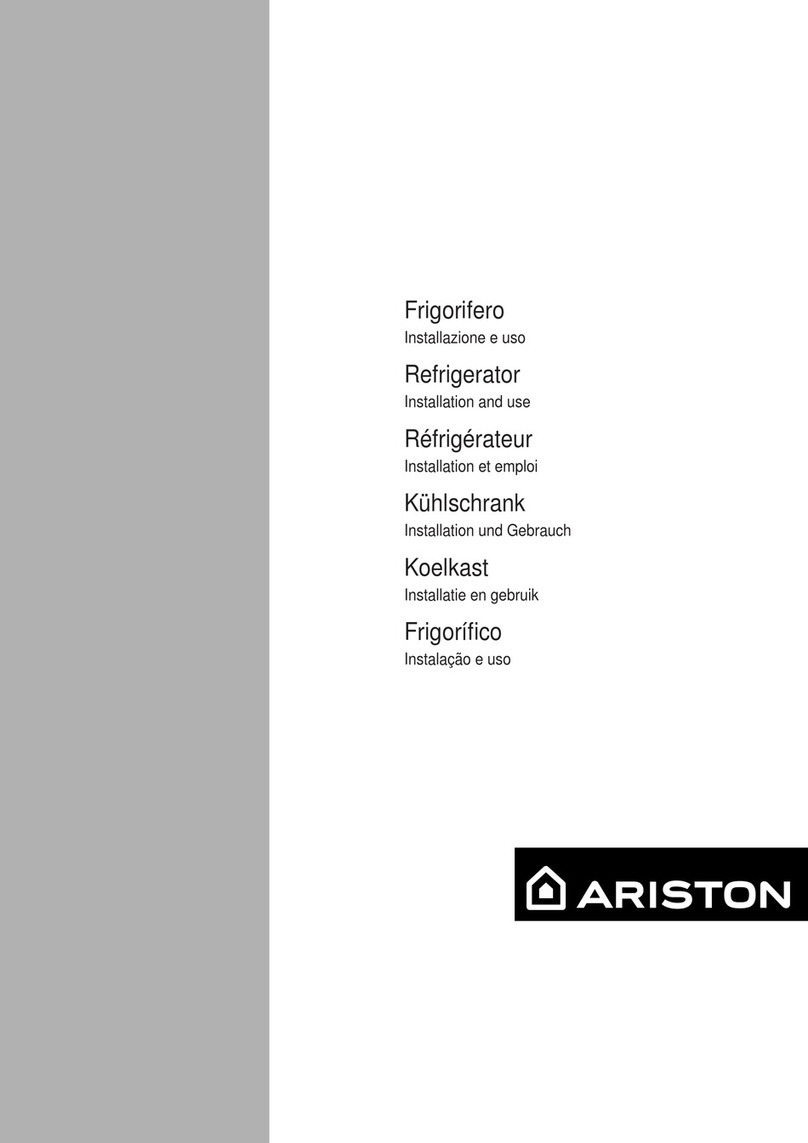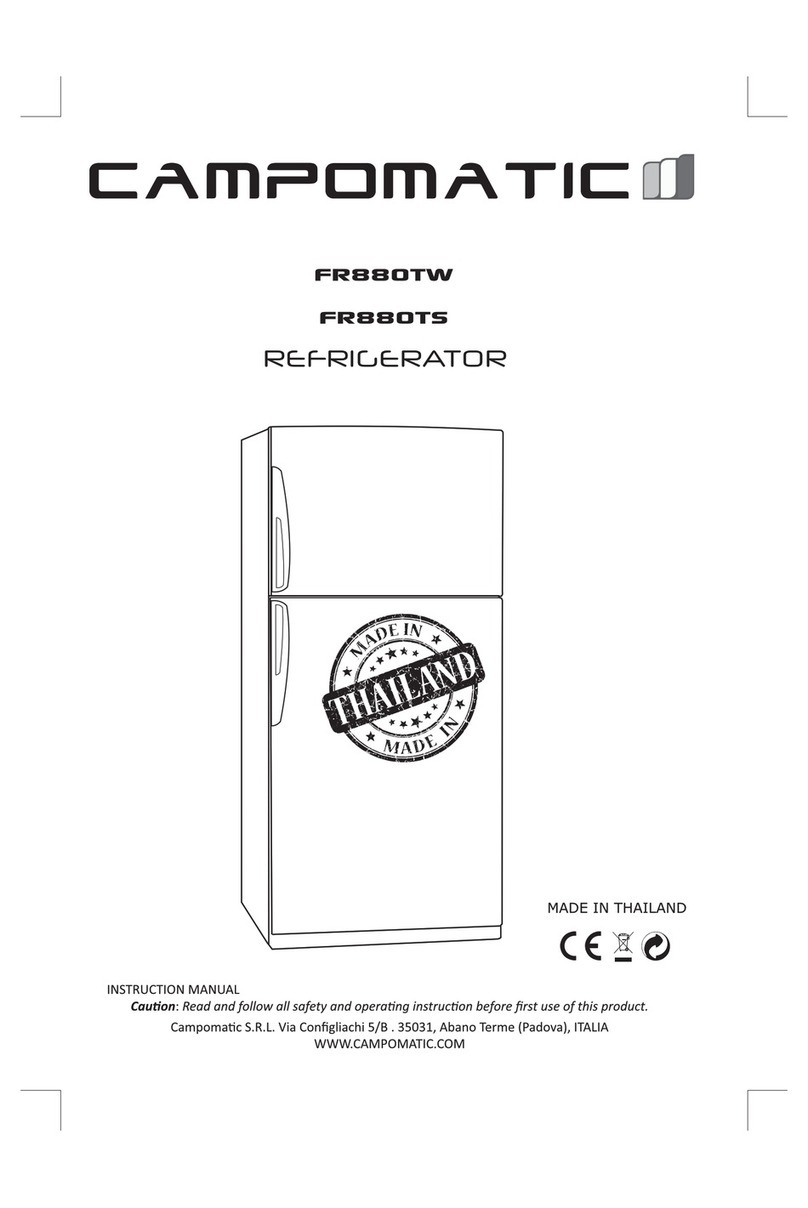BEVOi BVIREF10W User manual

BEVOi
INSTRUCTION
MANUAL
Models:
BVIREF10SS
BVIREF10W
as
Please
read
the
Manual
carefully
before
use.
The
Manual
shall
be
kept
in
good
custody
for
later
reference

TABLE
OF
CONTENTS
Appliance
Safety
Important
Safeguards
Location
of
Parts
Installation
Instructions
Before
Using
your
Appliance
Installation
of
your
Appliance
Leveling
your
Appliance
Electrical
Connection
Extension
Cord
Reversing
the
Door
Sw/ng
Operating
Instructions
Care
and
Maintenance
Cleaning
your
Appliance
Cleaning
the
Glass
Shelves
Defrosting
Power
Failure
Moving
Vacations
Troubleshooting
Limited
Warranty
3
3-4
5
6-10
6
6
6
7
7
8-10
10
11-12
11
11
11
11
12
12
13
16
2

APPLIANCE
SAFETY
Your
safety
and
the
safety
of
others
are
very
important.
We
have
provided
many
important
safety
messages
in
this
manual
and
on
your
appliance.
Always
read
and
obey
all
safety
messages.
This
is
the
Safety
Alert
Symbol.
The
symbol
alerts
you
to
potential
hazards
that
can
kill
or
injure
you
and
others.
All
safety
messages
will
follow
the
Safety
Alert
Symbol
and
either
the
word
DANGER
or
WARNING.
Jk
DANGER
A
DANGER
means
that
failure
to
heed
this
safety
statement
may
result
in
severe
personal
injury
or
death.
A
WARNING
WARNING
means
that
failure
to
heed
this
safety
statement
may
result
in
extensive
product
damage,
serious
personal
injury,
or
death.
All
safety
messages
will
alert
you
about
the
potential
hazard,
tell
you
how
to
reduce
the
chance
of
injury,
and
let
you
know
what
can
happen
if
the
instructions
are
not
followed.
IMPORTANT
SAFEGUARDS
Before
the
appliance
is
used,
it
must
be
properly
positioned
and
installed
as
described
in
this
manual,
so
read
the
manual
carefully.
To
reduce
the
risk
of
fire,
electrical
shock
or
injury
when
using
the
appliance,
follow
basic
precautions,
including
the
following;
A
DANGER
A
●
Plug
Into
a
grounded
3-prong
outlet,
do
not
remove
grounding
prong,
do
not
use
an
adapter,
and
do
not
use
an
extension
cord,
●
Replace
all
panels
before
operating.
●
It
is
recommended
that
a
separate
circuit
serving
only
your
appliance
be
provided.
Use
receptacles
that
cannot
be
turned
off
by
a
switch
or
pull
chain.
●
Never
clean
appliance
parts
with
flammable
fluids.
These
fumes
can
create
a
fire
hazard
or
explosion.
And
do
not
store
or
use
gasoline
or
other
flammable
vapors
and
liquids
in
the
vicinity
of
this
or
any
other
appliance.
The
fumes
can
create
a
fire
hazard
or
explosion.
●
Do
not
connect
or
disconnect
the
electric
plug
when
your
hands
are
wet.
●
Unplug
the
appliance
or
disconnect
power
before
cleaning
or
servicing.
Failure
to
do
so
can
result
in
electrical
shock
or
death.
●
Do
not
attempt
to
repair
or
replace
any
part
of
your
appliance
unless
it
is
specifically
recommended
in
this
manual.
All
other
servicing
should
be
referred
to
a
qualified
technician.
●
This
appliance
is
CFG-
and
FlFC-free
and
contains
small
quantities
of
Isobutane
(R600a)
which
is
environmentally
friendly,
but
flammable.
It
does
not
damage
the
ozone
layer,
nor
does
it
increase
the
greenhouse
effect.
Care
must
be
taken
during
transportation
and
setting
up
of
the
appliance
that
no
parts
of
the
cooling
system
are
damaged.
Leaking
coolant
can
ignite
and
may
damage
the
eyes.
3

●
In
the
event
of
any
damage:
o
Avoid
open
flames
and
anything
that
creates
a
spark,
o
Disconnect
from
the
power
supply
o
Air
the
room
in
which
the
appliance
is
located
for
several
minutes
and
o
Contact
the
Service
Department
for
advice.
●
The
more
coolant
there
is
in
an
appliance,
the
larger
the
room
it
should
be
installed
in.
In
the
event
of
a
leakage,
if
the
appliance
is
in
a
small
room,
there
is
the
danger
of
combustible
gases
building
up.
For
every
ounce
of
coolant,
at
least
325
cubic
feet
of
room
space
is
required.
The
amount
of
coolant
in
the
appliance
is
stated
on
the
data
plate
inside
the
appliance.
It
is
hazardous
for
anyone
other
than
an
Authorized
Sen/ice
Person
to
carry
out
servicing
or
repairs
to
this
appliance.
●
Take
serious
care
when
handling,
moving
and
using
the
appliance
to
avoid
either
damaging
the
refrigerant
tubing
or
increasing
the
risk
of
a
leak.
●
Replacing
component
parts
and
servicing
shall
be
done
by
factory
authorized
service
personnel,
so
as
to
minimize
the
risk
of
possible
ignition
due
to
incorrect
parts
or
improper
service.
▲
warning
FOLLOW
WARNING
CALLOUTS
BELOW
ONLY
WHEN
APPLICABLE
TO
YOUR
MODEL
Use
two
or
more
people
to
move
and
install
appliance.
Failure
to
do
so
can
result
in
back
or
other
injury.
To
ensure
proper
ventilation
for
your
appliance,
the
front
of
the
unit
must
be
completely
unobstructed.
Choose
a
well-ventilated
area
with
temperatures
above
44°F
(7°C)
and
below
90°F
(32°C).
The
appliance
should
not
be
located
next
to
ovens,
grills
or
other
sources
of
high
heat.
The
appliance
must
be
installed
with
all
electrical,
water
and
drain
connections
in
accordance
with
state
and
local
codes.
A
standard
electrical
supply
(115
V
AC
only,
60
Hz),
properly
grounded
in
accordance
with
the
National
Electrical
Code
and
local
codes
and
ordinances,
is
required.
Do
not
kink
or
pinch
the
power
supply
cord
of
the
appliance.
The
size
of
the
fuse
(or
circuit
breaker)
should
be
15
amperes.
It
is
important
that
the
appliance
be
leveled
in
order
to
work
properly.
You
may
need
to
make
several
adjustments
to
level
it.
All
installations
must
be
in
accordance
with
local
plumbing
code
requirements.
Make
certain
that
the
pipes
are
not
pinched,
kinked
or
damaged
during
installation.
Check
for
leaks
after
connection.
Never
allow
children
to
operate,
play
with
or
crawl
inside
the
appliance.
Do
not
use
solvent-based
cleaning
agents
or
abrasives
on
the
interior.
These
cleaners
may
damage
or
discolor
the
interior.
Use
this
appliance
only
for
its
intended
purpose
as
described
in
this
Instruction
Manual.
Keep
fingers
out
of
the
"pinch
point"
areas.
Clearances
between
the
door
and
cabinet
are
necessarily
small.
Be
careful
closing
the
door
when
children
are
in
the
area.
A
DANGER
A
Risk
of
child
entrapment!
Child
entrapment
and
suffocation
are
not
problems
of
the
past.
Junked
or
abandoned
appliances
are
still
dangerous,
even
if
they
will
“just
sit
for
a
few
days”.
Before
discarding
your
old
appliance:
●
Take
off
the
doors
●
Leave
the
shelves
in
place
so
that
children
may
not
easily
climb
inside.
-
SAVE
THESE
INSTRUCTIONS
-
4

LOCATION
OF
PARTS
vf
fserfHr
wifp
iheir
i
$
D<sar
IrdY
LCDtighi?
r«mp«fjture
tpnt(u!
aajiel
ii
i.
O
Du<!t
trav
i
I
if
Daar
tray
TruiU
frf
vB^rtatiles.
k<s<
?ssv«r
glate
Fryi?$
and
yegetalilejf
bs*.
4ttE
NOTE:
The
picture
above
is
for
reference
only.
The
actual
configuration
of
your
unit
may
differ.
Refrigerated
Chamber
●
The
refrigerated
chamber
is
suitable
for
storage
of
a
variety
of
fruits,
vegetables,
beverages
and
other
food
consumed
in
the
short
term.
●
Let
any
cooked
foods
cool
to
room
temperature
before
storage
●
Seal
any
foods
before
storage
●
The
glass
shelves
can
be
adjusted
up
or
down
for
a
reasonable
amount
of
storage
space
and
easy
use.
Freezer
Chamber
●
The
low
temperature
freezing
chamber
may
keep
food
fresh
for
a
long
time
and
is
used
to
store
frozen
foods
and
making
ice.
●
The
freezing
chamber
is
suitable
for
storage
of
meat,
fish,
vegetables,
and
other
foods
not
to
be
consumed
in
short
term.
●
Large
portions
of
meat
are
should
be
divided
into
smaller
pieces
for
easy
access.
Consume
all
foods
within
the
proper
shelf
time.
5

INSTALLATION
INSTRUCTIONS
Before
Using
your
Appliance
●
Remove
the
exterior
and
interior
packing.
●
Before
connecting
the
appliance
to
the
power
source,
let
it
stand
upright
for
approximately
2
hours.
This
will
reduce
the
possibility
of
a
malfunction
in
the
cooling
system
from
handling
during
transportation.
●
Clean
the
interior
surface
with
lukewarm
water
using
a
soft
cloth.
●
Install
the
handle
on
the
door,
if
it
is
not
already
attached.
Installation
of
your
Appliance
●
The
appliance
is
designed
free
standing
installation
for
indoor
use.
CAUTION:
This
appliance
is
not
designed
for
the
storage
of
medicine
or
other
medical
products.
●
Place
your
appliance
on
a
floor
that
is
strong
enough
to
support
it
when
it
is
fully
loaded.
To
level
the
unit,
adjust
the
front
leveling
legs.
●
Keep
4”
of
space
between
the
back
and
the
sides
of
the
unit
and
11”
at
the
top
to
allow
proper
air
circulation
to
cool
the
compressor
and
condenser.
●
Keep
away
from
heat
and
avoid
direct
sunlight.
Do
not
place
the
unit
in
moist
or
watery
places
to
prevent
rust
or
reduction
of
insulating
effect.
●
Plug
the
appliance
into
an
exclusive,
properly
grounded
wall
outlet.
Leveling
your
Appliance
T
Adjust
the
left
and
right
front
leveling
feet
to
ensure
your
refrigerator-freezer
is
on
a
horizontal
level.
●
Turn
the
front
leveling
feet
clockwise
to
increase
the
height
of
your
refrigerator-freezer.
●
Turn
the
front
leveling
feet
counterclockwise
to
lower
the
height
of
your
refrigerator-freezer
6

Electrical
Connection
WARNING
Improper
use
of
the
grounded
plug
can
result
In
the
risk
of
electrical
shock.
If
the
power
cord
Is
damaged,
have
it
replaced
by
a
qualified
electrician
or
an
authorized
service
center.
This
appliance
should
be
properly
grounded
for
your
safety.
The
power
cord
of
this
appliance
is
equipped
with
a
three-prong
plug
which
mates
with
standard
three-prong
wall
outlets
to
minimize
the
possibility
of
electrical
shock.
Do
not
under
any
circumstances
cut
or
remove
the
third
(ground)
prong
from
the
power
cord
supplied.
For
personal
safety,
this
appliance
must
be
properly
grounded.
Any
questions
concerning
power
and/or
grounding
should
be
directed
toward
a
certified
electrician
or
an
authorized
service
center.
This
appliance
requires
a
standard
115/120
Volt
AC
~60Hz
three-prong
grounded
electrical
outlet.
Have
the
wall
outlet
and
circuit
checked
by
a
qualified
electrician
to
make
sure
the
outlet
is
properly
grounded.
When
a
standard
2-prong
wall
outlet
is
encountered,
it
is
your
responsibility
and
obligation
to
have
it
replaced
with
a
properly
grounded
3-prong
wall
outlet.
To
prevent
accidental
injury,
the cord
should
be
secured
behind
the
appliance
and
not
left
exposed
or
dangling.
The
appliance
should
always
be
plugged
into
its
own
individual
electrical
outlet
which
has
a
voltage
rating
that
matches
the
rating
label
on
the
appliance.
This
provides
the
best
performance
and
also
prevents
overloading
house
wiring
circuits
that
could
cause
a
fire
hazard
from
overheating.
Never
unplug
the
appliance
by
pulling
on
the
power
cord.
Always
grip
the
plug
firmly
and
pull
straight
out
from
the
receptacle.
Repair
or
replace
immediately
all
power
cords
that
have
become
frayed
or
othenwise
damaged.
Do
not
use
a
cord
that
shows
cracks
or
abrasion
damage
along
its
length
or
at
either
end.
When
moving
the
appliance,
be
careful
not
to
damage
the
power
cord.
Extension
Cord
Because
of
potential
safety
hazards
under
certain
conditions,
it
is
strongly
recommended
that
you
do
not
use
an
extension
cord
with
this
appliance.
However,
if
you
must
use
an
extension
cord,
it
is
absolutely
necessary
that
it
be
a
UL/CUL-Listed,
3-wire
grounding
type
appliance
extension
cord
having
a
grounding
type
plug
and
outlet
and
that
the
electrical
rating
of
the
cord
be
115
volts
and
at
least
10
amperes.
7

Reversing
the
Door
Swing
If
you
find
the
direction
of
opening
the
door
of
the
appliance
inconvenient,
you
can
change
it.
Holes
on
the
opposite
side
have
already
been
prepared
at
the
factory.
To
reverse
your
door,
follow
the
instruction
on
the
next
page.
Tools
needed:
●
Phillips
head
screwdriver
●
5/16”
socket
and
rachet
●
Flat-head
screwdriver
●
Masking
tape
●
Putty
knife
1.
Unplug
the
appliance,
and
remove
all
items
from
the
door
shelves
and
the
interior.
2.
Remove
the
hinge
hole
cover
from
the
top
left
side
of
the
appliance.
3.
Remove
the
upper
hinge
cover
from
the
top
right
side
of
the
appliance.
Then,
remove
the
hinge
screws
and
upper
hinge.
4.
Lift
the
upper
door
off
of
the
cabinet.
hole
..
upper
hinge
cover
screw
upper
hinge
5.
Place
the
upper
door
on
a
soft
surface
to
ensure
the
door
is
not
scratched
or
damaged.
6.
Unscrew
the
middle
hinge
screws,
and
remove
the
middle
hinge.
7.
Remove
the
two
hinge
hold
plugs,
the
screw,
and
screw
cap
from
the
middle
beam
on
the
opposite
side
of
the
appliance.
8.
Remove
the
refrigerator
door
from
the
cabinet.
middle
hinge
screw
hoie
plug-
screw
screv/cap
8

9.
Carefully
tip
the
unit
back,
and
remove
the
adjusting
feet,
lower
hinge
screws,
and
the
lower
hinge
assembly.
10.
Install
the
lower
hinge
assembly
on
the
other
side
of
the
cabinet,
and
install
the
adjusting
feet
again.
Lower
hinge
assembly
screw
11.
Dismantle
the
limit
blocks
and
screws
on
the
lower
cover
of
the
refrigerator
and
freezer
door.
Install
them
on
the
opposite
side
of
both
doors.
Then,
install
the
sleeve
pipe
on
the
upper
cover
of
the
refrigerator
door
on
the
other
side.
sleeve
pipe
limit
blocks
screw
stopper
’’VX
screw
tf
12.
Set
the
refrigerator
door
onto
the
lower
hinge,
and
then
install
the
middle
hinge
and
hinge
hole
caps.
\
9

13.
Set
the
freezer
door
onto
the
middle
hinge,
and
then
install
the
upper
hinge
to
secure
the
freezer
door,
making
sure
to
secure
the
hinge
cover
and
hinge
hole
cover.
hole
cover
hinge
cover
screw
rif
upper
hinge
Changing
the
Interior
Light
Replacing
the
LED
lamps
should
be
done
by
the
manufacturer
or
qualified
technician.
OPERATING
YOUR
APPLIANCE
Control
Panel
●
The
control
panel
features
a
SET
Q
key
and
five
temperature
settings.
●
The
settings
cycle
from
1
(coldest)
to
5
(least
cold)
each
time
the
SET
key
is
pressed.
-a
CO..Drf-:
@
.«
■o
Error
Codes
a
When
an
error
occurs,
the
corresponding
LED
light
combination
corresponds
to
the
specific
error:
~a
n
Error
Code
Error
Description
Q
LED
1
and
2
flashing
Temperature
sensor
failure
in
refrigerator
LED
1
and
3
flashing
Temperature
sensor
failure
in
the
freezer
TEMPERATURE
LED
1
and
4
flashing
Ring
temperature
sensor
failure
10

CARE
AND
MAINTENANCE
CAUTION:
Be
sure
to
unplug
the
appliance
before
cleaning
to
avoid
the
risk
of
electric
shock.
Cleaning
your
Appliance
●
Dust
accumulates
behind
and
on
the
unit
should
be
cleaned
regularly
to
ensure
cooling
efficiency
and
energy
consumption,
●
Check
the
door
gasket
regularly
to
make
sure
there
is
no
accumulated
debris.
Clean
the
door
gasket
with
a
soft
cloth
dampened
with
soapy
water
or
diluted
detergent.
●
The
interior
of
the
refrigerator
should
be
cleaned
regularly
to
avoid
any
odor
buildup.
●
Do
not
use
soap,
detergent,
scrub
powder,
spray
cleaner,
etc.,
as
these
may
cause
odors
in
the
interior
of
the
refrigerator.
●
Use
a
soft
cloth
or
sponge
to
clean
the
inside
of
the
unit,
using
a
solution
of
two
tablespoons
of
baking
soda
and
a
quart
of
warm
water.
Then
rinse
with
clean
water,
and
then
wipe
clean
with
a
soft
towel.
After
cleaning,
open
the
door
and
let
the
unit
dry
naturally
before
turning
the
power
back
on.
●
For
areas
that
are
difficult
to
clean
in
(such
as
narrow
gaps
or
corners),
it
is
recommended
to
wipe
them
regularly
with
a
soft
rag
or
brush,
or
when
necessary,
an
auxiliary
tool
(such
as
a
thin
stick)
to
ensure
no
contaminant
or
bacterial
accumulation
in
these
areas.
●
Clean
the
bottle
frame,
shelves
and
drawers
with
a
soft
cloth
dampened
with
soapy
water
or
diluted
detergent.
Dry
with
a
soft
cloth.
●
Wipe
the
outer
surface
of
the
unit
with
a
soft
cloth
dampened
with
soapy
water
or
diluted
detergent,
and
then
wipe
dry.
●
Do
not
use
hard
brushes,
clean
steel
balls,
wire
brushes,
abrasives
(such
as
toothpastes),
organic
solvents
(such
as
alcohol,
acetone,
banana
oil,
etc.),
boiling
water,
acid
or
alkaline
items,
which
may
damage
the
surface
and
interior
of
the
unit.
Boiling
water
and
organic
solvents
such
as
benzene
may
deform
or
damage
plastic
parts.
●
Do
not
rinse
directly
with
water
or
other
liquids
during
cleaning
to
avoid
short
circuits
or
potentially
affect
the
electrical
insulation.
Cleaning
the
Glass
Shelves
1.
Lift
up
the
front
of
the
glass
shelf,
and
then
pull
the
shelf
out.
2.
Clean
as
needed.
3.
Reinstall
the
shelf
by
placing
the
rear
of
the
shelf
into
position
first.
Then,
carefully
lower
the
front
of
the
shelf
into
place.
Defrosting
The
appliance
uses
an
automatic
defrosting
function.
Frost
formed
due
to
the
change
of
season
or
temperature
may
also
be
manually
removed
by
disconnecting
the
appliance
from
the
power
supply
or
by
wiping
with
a
dry
towel.
Power
Failure
In
case
of
a
power
failure,
even
in
warmer
weather,
foods
inside
the
appliance
can
be
kept
for
several
hours;
during
the
power
failure,
limit
the
times
the
door
is
opened,
and
do
not
add
more
fresh
food
into
the
appliance.
11

Moving
●
Before
the
unit
is
moved,
remove
all
of
the
items
stored
inside,
fix
the
glass
shelves,
drawers,
freezing
chamber
drawers,
etc,
with
tape,
and
tighten
the
leveling
feet.
Then,
close
the
doors
and
fix
them
with
tape.
●
During
moving,
the
appliance
shall
not
be
laid
upside
down
or
horizontally,
or
be
vibrated;
the
inclination
during
movement
shall
be
no
more
than
45°.
Vacations
●
Short
vacations:
Leave
the
appliance
operating
during
vacations
of
less
than
three
weeks.
●
Long
vacations:
If
the
appliance
will
not
be
used
for
several
months,
remove
all
items
and
turn
the
unit
off.
Clean
and
dry
the
interior
thoroughly.
To
prevent
odor
and
mold
growth,
leave
the
door
open
slightly,
blocking
it
open
if
necessary.
12

TROUBLESHOOTING
You
can
solve
many
common
problems
easily,
saving
you
the
cost
of
a
possible
service
call.
Try
the
suggestions
below
to
see
if
you
can
solve
the
problem
before
calling
the
servicer.
Check
whether
the
appliance
is
connected
to
power
or
whether
the
plug
is
in
well
contact.
Check
whether
the
voltage
is
too
low.
Check
whether
there
is
a
power
failure
or
partial
circuits
have
tripped.
Tightly
wrap
food
to
prevent
possible
odor.
Check
whether
there
is
any
rotten
food.
Clean
the
inside
of
the
appliance.
The
unit
stops
working.
There
is
an
odor
inside
the
unit.
Long
operation
of
the
compressor
is
normal
in
summer
when
the
ambient
temperature
is
high.
It
is
not
recommended
to
load
a
large
amount
of
food
in
the
appliance
at
one
time.
Cool
food
to
room
temperature
before
loading
into
the
appliance.
The
doors
are
opened
too
frequently.
The
compressor
runs
too
long.
Light
fails
to
turn
on
Check
whether
the
appliance
is
connected
to
power
supply
and
whether
the
illuminating
light
is
damaged.
Doors
cannot
be
properly
closed
The
door
is
blocked
by
food
packages.
The
appliance
is
not
level.
Loud
noise
Check
whether
the
floor
is
level
and
whether
the
appliance
is
placed
stably.
Check
whether
accessories
are
placed
at
proper
locations.
Door
seal
fails
to
be
tight
Remove
foreign
matters
on
the
door
seal.
Heat
the
door
seal
and
then
cool
it
for
restoration
(ex:
blow
it
with
an
electrical
drier
or
use
a
hot
towel
for
heating).
There
is
too
much
food
in
the
chamber
or
the
food
stored
contains
too
much
water,
resulting
in
heavy
defrosting.
The
doors
are
not
closed
properly,
resulting
in
frosting
due
to
the
entry
of
air
and
increased
water
due
to
defrosting.
Heat
dissipation
of
the
built-in
condenser
via
the
housing,
is
normal.
When
the
housing
becomes
hot
due
to
high
ambient
temperatures
and
the
storage
of
too
much
food,
it
is
recommended
to
provide
sound
ventilation
to
facilitate
heat
dissipation.
Condensation
on
the
exterior
surface
and
door
seals
of
the
appliance
is
normal
when
the
ambient
humidity
is
too
high.
Just
wipe
the
condensate
with
a
clean
towel.
Water
pan
overflows
Hot
housing
Surface
condensation
Buzz:
The
compressor
may
produce
a
buzzing
noise
during
operation,
and
the
buzzes
are
loud
particularly
upon
start
or
stop.
This
is
normal.
Creak:
Refrigerant
flowing
inside
of
the
appliance
may
produce
a
creaking
sound,
which
is
normal.
Abnormal
noise
If
you've
checked
the
table
above
and
find
that
you
still
need
help
with
your
appliance,
call
our
Customer
Service
facility
at
800-932-4267
between
9:00AM
and
5:00PM
ET.
We
will
do
our
best
to
answer
your
questions.
13
This manual suits for next models
1
Table of contents
Other BEVOi Refrigerator manuals
